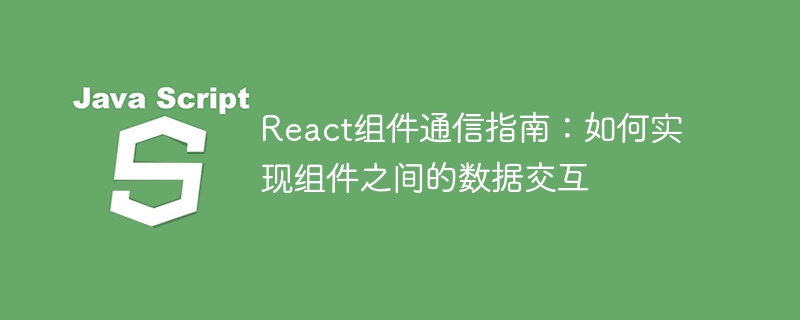Home >Web Front-end >JS Tutorial >React Component Communication Guide: How to implement data interaction between components
React Component Communication Guide: How to implement data interaction between components
- WBOYWBOYWBOYWBOYWBOYWBOYWBOYWBOYWBOYWBOYWBOYWBOYWBOriginal
- 2023-09-28 08:13:051343browse

React Component Communication Guide: How to implement data interaction between components
In React development, data interaction between components is a very important function. Usually, there are multiple components in an application, and they need to share data or transfer state between them. In order to achieve this kind of data interaction between components, React provides a variety of methods and patterns.
This article will introduce common methods to implement data interaction between components in React, and provide specific code examples.
1. Parent-child component communication
In React, components can have a relationship between parent components and child components. Through the props attribute, parent components can pass data to child components. Subcomponents can receive this data through props to achieve data transfer and interaction.
The following is a simple example of parent-child component communication:
// 父组件
class ParentComponent extends React.Component {
render() {
const data = "Hello, I'm data from parent component!";
return <ChildComponent data={data} />;
}
}
// 子组件
class ChildComponent extends React.Component {
render() {
return <p>{this.props.data}</p>;
}
}In the above example, the parent component ParentComponent passes to the child component ChildComponent A property named data is created, and the subcomponent receives and displays the value of the property through props.data.
2. Child-parent component communication
Sometimes, a child component needs to pass data to the parent component or trigger certain behaviors of the parent component. In React, communication between child and parent components can be achieved by using callback functions.
The following is an example of communication between child and parent components:
// 子组件
class ChildComponent extends React.Component {
handleClick() {
this.props.onChildClick("Hello, I'm data from child component!");
}
render() {
return <button onClick={this.handleClick.bind(this)}>Click Me</button>;
}
}
// 父组件
class ParentComponent extends React.Component {
handleChildClick(data) {
console.log(data);
}
render() {
return <ChildComponent onChildClick={this.handleChildClick.bind(this)} />;
}
}In the above example, when the child component is clicked, the onClick event handler function## will be called #handleClick. This function calls the callback function onChildClick passed by the parent component to the child component, and passes the child component's data to it as a parameter. The parent component receives this data by defining the handleChildClick function and processes it accordingly.
// 父组件
class ParentComponent extends React.Component {
constructor(props) {
super(props);
this.state = {
data: "Hello, I'm data from parent component!"
};
}
render() {
return (
<>
<SiblingComponentA data={this.state.data} />
<SiblingComponentB data={this.state.data} />
</>
);
}
}
// 兄弟组件A
class SiblingComponentA extends React.Component {
render() {
return <p>{this.props.data}</p>;
}
}
// 兄弟组件B
class SiblingComponentB extends React.Component {
render() {
return <p>{this.props.data}</p>;
}
}In the above example, a file named data is defined in the parent component ParentComponent state and pass it as a property to the two sibling components SiblingComponentA and SiblingComponentB. In this way, two sibling components can share the state of the parent component and realize data interaction between sibling components.
The above is the detailed content of React Component Communication Guide: How to implement data interaction between components. For more information, please follow other related articles on the PHP Chinese website!
Related articles
See more- An in-depth analysis of the Bootstrap list group component
- Detailed explanation of JavaScript function currying
- Complete example of JS password generation and strength detection (with demo source code download)
- Angularjs integrates WeChat UI (weui)
- How to quickly switch between Traditional Chinese and Simplified Chinese with JavaScript and the trick for websites to support switching between Simplified and Traditional Chinese_javascript skills

